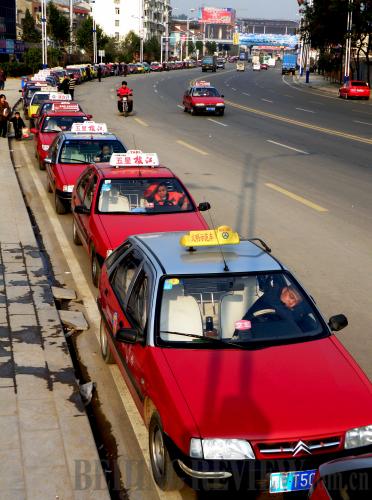|
 |
|
ENERGY SHORTAGE: Taxis line up outside a gas station in Yichang City in central China's Hubei Province. The snowstorm in November caused energy shortages in many cities (CNSPHOTO) |
CPI data will increase within a short period of time, said Ha Jiming, chief economist at the China International Capital Corp. Ltd. (CICC) China currently must confront the inflationary pressures caused by a relaxed monetary policy and an inflow of hot money, he said.
Approaching inflation
With memories of price rises in 2007 still fresh in people's minds, a new round of price increases may stun the public if prices of basic resources begin to soar.
Since the price of fuel, electricity, water and coal for domestic use accounts for 6 percent of CPI, recent price increases will surely be reflected soon in the CPI.
Essential resource products, like gasoline, electricity, natural gas and water, are critical to overall pricing. An increase among these resources will drive price hikes in a series of other products, said Guo Tianyong, Director of the Research Center of the Chinese Banking Industry at the Central University of Finance and Economics.
According to Li Huiyong, chief analyst of microeconomics at Shenyin and Wanguo Securities Co. Ltd., the 10-percent increase in basic raw materials will cause an increase of 0.5-percentage point in the CPI, and an increase of 0.2-percentage point in commodity prices.
As for the food sector, the recent snow storm experienced nationwide bore down on agricultural products. According to the Ministry of Commerce, from November 9-16, the price of agricultural products ceased its decline and saw an increase of 1 percent week on week. In the snow-hit Hebei Province, the price of cabbage climbed to 20 yuan ($2.93) per kg, 10 times higher than the normal level.
Out of the total personal expenditures of developing countries like China, India and Viet Nam, food usually makes up a relatively large proportion. In this sense, the price hike in food products will cause inflation to occur more easily than in developed countries, said Ha.
The tendency of commodity price increases has been all but ensured the CPI year on year in 2009 and 2010 will stand at 4 percent, said a research report issued by the Bank of Communications.
Also, China's inflation is expected to appear earlier than that in the United States, said Ha.
In an attempt to alleviate the impact of the global financial crisis, the Chinese Government has been largely expanding its money supply. In the first half of this year, renminbi loans skyrocketed to 5.83 trillion yuan ($853 billion).
A portion of the loans did not go to the real economy, instead routed into speculative investment, driving inflation expectations up, said Zhao Xijun, Deputy Dean of the School of Finance at Renmin University.
The monetary expansion will speed up the arrival of inflation, said Zhao.
Measures to be taken
With a clearer economic recovery in sight, China, for the first time since the outbreak of the global financial crisis, has placed inflation control on its list of top priorities.
Maintaining growth, adjusting the economic structure and managing inflation expectations will be the key items for macro adjustment in the coming months, which was announced in a statement made after a meeting of the State Council chaired by Premier Wen Jiabao in October.
The State Council's recognition of the inflation worries demonstrates that such risks have aroused the attention of policymakers, which may exert influence on the monetary policy, said Peng Xingyun, a researcher at the Institute of Finance and Banking at the Chinese Academy of Social Sciences.
According to the data released by the People's Bank of China, new renminbi loans in October totaled 253 billion yuan ($37 billion), a dramatic decrease of 50 percent compared with that of September.
The new loan plummet showed the country's direction in adjusting macroeconomy, said Ha of CICC.
According to a report by the Beijing-based China Business Journal, although the giant stimulus package kept China afloat and ensured a GDP growth rate of 8 percent this year, blind and redundant investment also made the stimulus measure unsustainable. Since a large part of the investment went to industries with high-energy consumption and long construction periods, it will alarmingly cause the supply tensions in fuel, gas, electricity and transportation sectors.
According to the National Bureau of Statistics, China's investment in heavy industry increased by 18.9 percent year on year, 3.3 percentage points more than that of September. The power consumption in October similarly witnessed a growth of 17.3 percent.
As should have been expected, the growth propelled by investments in the heavy and chemical industry would easily cause resource shortages, said the China Business Journal report.
To tide over this predicament, adjustments need to be made in the investment structure, not only through credit control and monetary policy but also through resource pricing and reform, many economists said.
After decades of development and reform, the market pricing mechanism of products, production material and services has been established. But the resource product pricing still lags behind the economic development, and is still controlled by the government.
Since China remains on the brink of a CPI increase, measures should be taken to seize the opportunity to reform the resource pricing mechanism, said Lin Boqiang, a professor at the China Energy Research Center of Xiamen University.
The NDRC has ordered local governments to study a progressive pricing system that charges increased rates for increased use of electricity and other basic resources. The implementation of this progressive electricity pricing will help establish social fairness and encourage residents to save electricity, water and reduce energy squandering, said Lin. | 